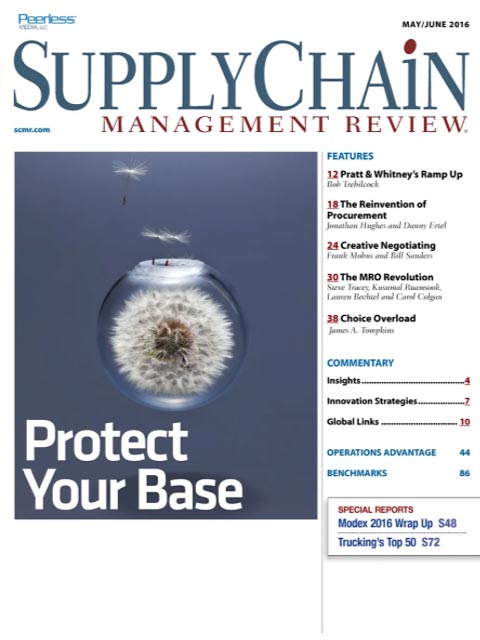Sorry, but your login has failed. Please recheck your login information and resubmit. If your subscription has expired, renew here.
May-June 2016
The procurement function is at an inflection point.” So begins “The reinvention of procurement," an article by Jonathan Hughes and Danny Ertel, partners at the Boston-based consulting firm Vantage Partners. The authors argue that while many leading companies have transformed their procurement organizations into a linchpin of their enterprise strategy, far too many others remain trapped by procurement models that are out of date in today’s fastpaced economy, where the acquisition of innovation, collaboration, services and solutions is more important than transactions based on the lowest cost per unit. Reinvention is a fitting theme for… Browse this issue archive.Need Help? Contact customer service 847-559-7581 More options
“This changes everything.” So goes Pratt & Whitney’s tagline for the PurePower PW1000G family of geared turbofan jet engines. Pratt invested $10 billion and 20 years of R&D into the development of the new engine, which relies on a state-of-the-art gear system that separates the engine fan from the low pressure compressor and turbine. The design allows each of the modules to operate at their optmum speeds: The fan rotates at a slow speed while the low pressure compressor and turbine operate at high speeds, increasing engine efficiency and delivering significantly lower fuel consumption, emissions and noise, according to company reports.
How much lower? The new design,considered revolutionary in the industry, boasts double-digit fuel burn reduction, a 50% reduction in noise and low emissions.
With orders in hand from Airbus, Bombardier, Embraer and Mitsubishi for some 7,000 engines totaling more than $18 billion, Pratt & Whitney’s business is about to ramp up in an unprecedented way. Production is forecast to double by 2020 — indeed the project to meet this demand is known internally as the “Ramp Up”.
 |
This complete article is available to subscribers
only. Click on Log In Now at the top of this article for full access. Or, Start your PLUS+ subscription for instant access. |
SC
MR
Sorry, but your login has failed. Please recheck your login information and resubmit. If your subscription has expired, renew here.
May-June 2016
The procurement function is at an inflection point.” So begins “The reinvention of procurement," an article by Jonathan Hughes and Danny Ertel, partners at the Boston-based consulting firm Vantage Partners.… Browse this issue archive. Access your online digital edition. Download a PDF file of the May-June 2016 issue.
 |
Download Article PDF |
“This changes everything.” So goes Pratt & Whitney's tagline for the PurePower PW1000G family of geared turbofan jet engines. Pratt invested $10 billion and 20 years of R&D into the development of the new engine, which relies on a state-of-the-art gear system that separates the engine fan from the low pressure compressor and turbine. The design allows each of the modules to operate at their optmum speeds: The fan rotates at a slow speed while the low pressure compressor and turbine operate at high speeds, increasing engine efficiency and delivering significantly lower fuel consumption, emissions and noise, according to company reports.
How much lower? The new design,considered revolutionary in the industry, boasts double-digit fuel burn reduction, a 50% reduction in noise and low emissions.
With orders in hand from Airbus, Bombardier, Embraer and Mitsubishi for some 7,000 engines totaling more than $18 billion, Pratt & Whitney's business is about to ramp up in an unprecedented way. Production is forecast to double by 2020 — indeed the project to meet this demand is known internally as the “Ramp Up”.
 |
SUBSCRIBERS: Click here to download PDF of the full article. |
SC
MR

Latest Supply Chain News
- AI, virtual reality is bringing experiential learning into the modern age
- Humanoid robots’ place in an intralogistics smart robot strategy
- Tips for CIOs to overcome technology talent acquisition troubles
- There is still work to do to achieve supply chain stability
- Blooming success: The vital role of S&OE in nurturing global supply chains
- More News
Latest Resources

 Explore
Explore
Topics
Latest Supply Chain News
- AI, virtual reality is bringing experiential learning into the modern age
- Humanoid robots’ place in an intralogistics smart robot strategy
- Tips for CIOs to overcome technology talent acquisition troubles
- There is still work to do to achieve supply chain stability
- Blooming success: The vital role of S&OE in nurturing global supply chains
- Supply chain salaries, job satisfaction on the rise
- More latest news
Latest Resources

Subscribe

Supply Chain Management Review delivers the best industry content.

Editors’ Picks





